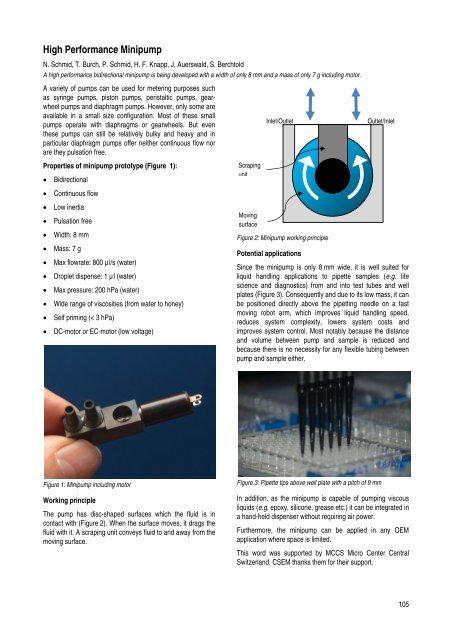CSEM Scientific and Technical Report 2008
CSEM Scientific and Technical Report 2008
CSEM Scientific and Technical Report 2008
Create successful ePaper yourself
Turn your PDF publications into a flip-book with our unique Google optimized e-Paper software.
High Performance Minipump<br />
N. Schmid, T. Burch, P. Schmid, H. F. Knapp, J. Auerswald, S. Berchtold<br />
A high performance bidirectional minipump is being developed with a width of only 8 mm <strong>and</strong> a mass of only 7 g including motor.<br />
A variety of pumps can be used for metering purposes such<br />
as syringe pumps, piston pumps, peristaltic pumps, gearwheel<br />
pumps <strong>and</strong> diaphragm pumps. However, only some are<br />
available in a small size configuration. Most of these small<br />
pumps operate with diaphragms or gearwheels. But even<br />
these pumps can still be relatively bulky <strong>and</strong> heavy <strong>and</strong> in<br />
particular diaphragm pumps offer neither continuous flow nor<br />
are they pulsation free.<br />
Properties of minipump prototype (Figure 1):<br />
• Bidirectional<br />
• Continuous flow<br />
• Low inertia<br />
• Pulsation free<br />
• Width: 8 mm<br />
• Mass: 7 g<br />
• Max flowrate: 800 µl/s (water)<br />
• Droplet dispense: 1 µl (water)<br />
• Max pressure: 200 hPa (water)<br />
• Wide range of viscosities (from water to honey)<br />
• Self priming (< 3 hPa)<br />
• DC-motor or EC-motor (low voltage)<br />
Figure 1: Minipump including motor<br />
Working principle<br />
The pump has disc-shaped surfaces which the fluid is in<br />
contact with (Figure 2). When the surface moves, it drags the<br />
fluid with it. A scraping unit conveys fluid to <strong>and</strong> away from the<br />
moving surface.<br />
Scraping<br />
unit<br />
Moving<br />
surface<br />
Inlet/Outlet Outlet/Inlet<br />
Figure 2: Minipump working principle<br />
Potential applications<br />
Since the minipump is only 8 mm wide, it is well suited for<br />
liquid h<strong>and</strong>ling applications to pipette samples (e.g. life<br />
science <strong>and</strong> diagnostics) from <strong>and</strong> into test tubes <strong>and</strong> well<br />
plates (Figure 3). Consequently <strong>and</strong> due to its low mass, it can<br />
be positioned directly above the pipetting needle on a fast<br />
moving robot arm, which improves liquid h<strong>and</strong>ling speed,<br />
reduces system complexity, lowers system costs <strong>and</strong><br />
improves system control. Most notably because the distance<br />
<strong>and</strong> volume between pump <strong>and</strong> sample is reduced <strong>and</strong><br />
because there is no necessity for any flexible tubing between<br />
pump <strong>and</strong> sample either.<br />
Figure 3: Pipette tips above well plate with a pitch of 9 mm<br />
In addition, as the minipump is capable of pumping viscous<br />
liquids (e.g. epoxy, silicone, grease etc.) it can be integrated in<br />
a h<strong>and</strong>-held dispenser without requiring air power.<br />
Furthermore, the minipump can be applied in any OEM<br />
application where space is limited.<br />
This word was supported by MCCS Micro Center Central<br />
Switzerl<strong>and</strong>. <strong>CSEM</strong> thanks them for their support.<br />
105








